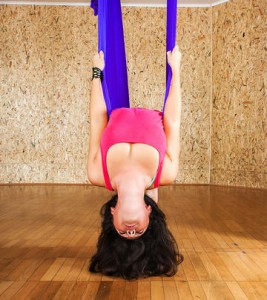Roll up your mat and take your yoga practice to new heights. Aerial yoga—in which practitioners strike poses while hanging several feet off the ground in hammocks—is a favorite with celeb yogis including Pink, Gwyneth Paltrow, and Lena Dunham. The workout trains your arms, legs, and core, and teaches students what a “lengthened spine” actually feels like—a lesson that transfers to their on-the-mats practices, explains Crunch group fitness instructor Nancy Elkes. “This can reduce back pain or injury.”
Plus, if you take advantage of aerial yoga’s upside-down moves—in-the-air versions of traditional yoga’s inversions—you can reap even more benefits. Research published in Disability and Rehabilitation shows that inversion therapy can help relieve aches in back-pain sufferers. And a 2013 BMC Research Notes study linked inversion yoga poses to increased heart rate variability, a key marker of a healthier, less-stressed heart.
Still, the biggest draw is the fun factor. But it’s hard to enjoy yourself when you’re freaked out that you’re going to fall, get tangled up, or otherwise look like an idiot. Here, aerial yoga instructors share six tips to make your first class a little more graceful.
1. Dress right.
To keep clothes from getting tangled in the hammock, or your shirt from falling around your head while you’re upside down, always opt for form-fitting fabrics. Elkes prefers cotton. “It’s cool and it doesn’t slip against the hammocks.” To prevent any irritation, full-length pants and shirts that at least cover your armpits—if not your whole arms—are best, she says.
2. Get to class early.
Unless you introduce yourself to the instructor, there’s no way for her to know if you’re brand-new to her class—or new to aerial yoga in general. So make sure to arrive a few minutes early, introduce yourself, and let her know you’re a newb, says AIR master trainer Cat Aldana. If you have any specific questions about the class, ask them then. It will be easier than trying to raise your hand when you’re hanging from the ceiling. Plus, once your instructor knows you’re new to aerial yoga, she’ll be sure to keep an extra eye on you throughout the class. Most instructors demonstrate a pose in the hammocks, then walk the room to help out and correct form, Aldana says.
3. Pick a hammock in the middle of the room.
It’s tempting to try to hide in the back of the class, but as soon as you attempt your first upside-down move, you’ll find yourself at the front, warns Christopher Harrison, founder of AntiGravity Fitness. He recommends nabbing a spot in the middle of the room. From there, you’ll have a good view for following along with others—plus all eyes will never be on you.
4. Eat an hour before class.
Too little or, on the flip side, too much food in your tummy can spell trouble during inversions, Harrison says. Go with an empty stomach and you risk getting dizzy. Go sporting a food baby and you risk stomach upset, indigestion, and, worst of all, vomiting. Elkes’ recommendation: Eat a balanced snack of carbs, protein, and healthy fats about an hour before class to keep your blood sugar levels steady without weighing your stomach down. Don’t drink any juices within 45 minutes of class starting, as they are acidic and can trigger heartburn, especially when you’re upside down.
5. Relax into the poses.
“Women think they are bigger than they are and they have a hard time trusting that the hammock will hold them up,” Elkes says. “They don’t fully relax and ground into the hammock, so they end up getting less out of the class.” While it’s understandable to be a bit apprehensive the first time around, remember that aerial yoga hammocks are rated to hold a lot of weight—many up to 1,000 pounds. Work with, not against gravity, and you’ll get a deeper stretch, build more muscle, and have a much better time.
6. Don’t rush.
Trying to move quickly from pose to pose can throw off your balance, prevent you from moving fully into each stretch, and potentially give you a case of the spins. “Moving too quickly in and out of inversions can cause dizziness or lightheadedness,” Aldana says. “Try holding inversions a little longer.”
Search from:http://www.fitnessmagazine.com/workout/yoga/help/aerial-yoga-tips/



